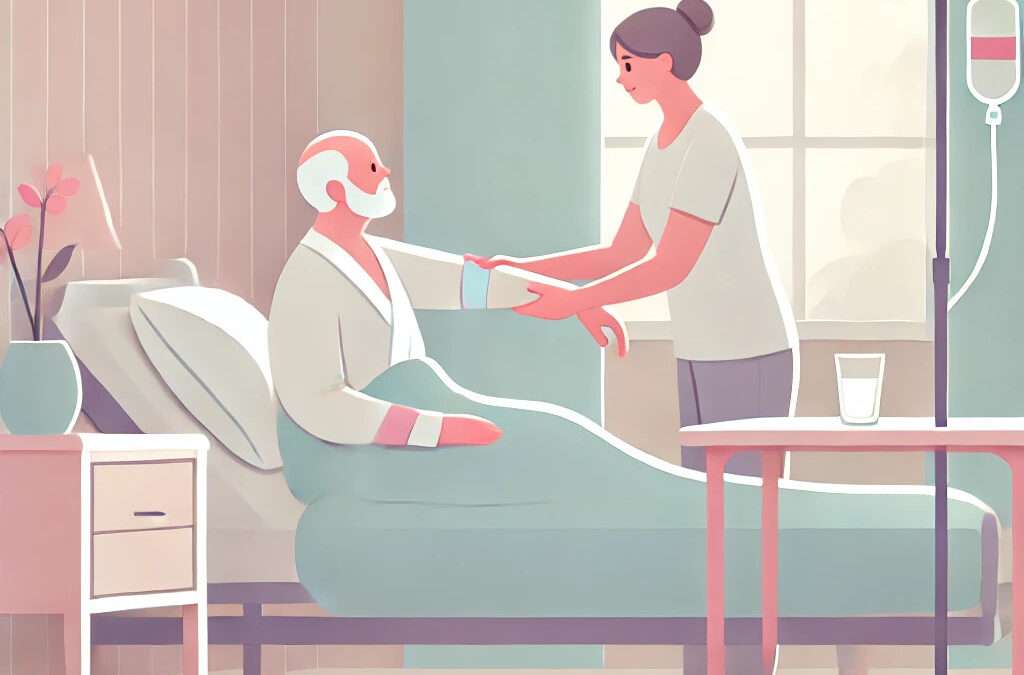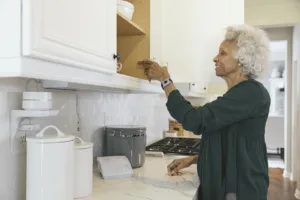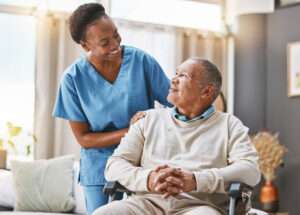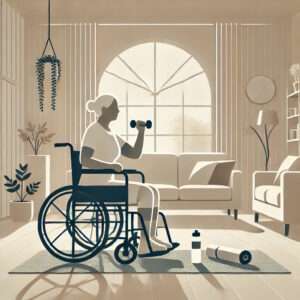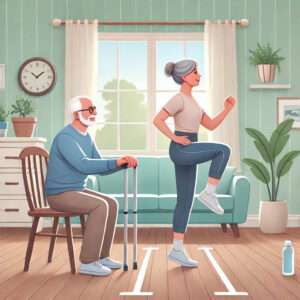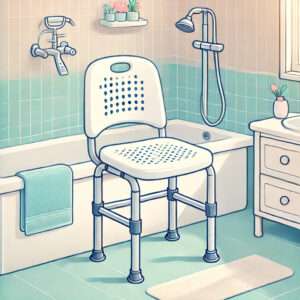Introduction
Life Doesn’t Pause with Limited Mobility
Life doesn’t pause when mobility becomes a challenge; in fact, it’s during these times that maintaining physical and mental well-being becomes even more crucial.
Addressing Feelings of Isolation and Helplessness
For many seniors confined to bed due to illness or injury, feelings of helplessness and isolation can be overwhelming. Questions like “How can I stay active?” or “Is there any way to improve my health from here?” often arise.
The Empowering Truth About Bed Exercises
But here’s the empowering truth: engaging in tailored exercises for bedridden seniors can significantly enhance quality of life. These exercises are not just about physical movement; they’re about regaining a sense of control and purpose.
What You’ll Learn
In this article, we’ll explore essential exercises that bring empowerment to rest. You’ll discover practical steps to boost circulation, strengthen muscles, and uplift spirits—all from the comfort of bed. Let’s embark on this journey towards improved well-being and renewed hope.
Understanding the Needs of Bedridden Seniors
1.1 Physical Challenges Faced
Being confined to bed brings a unique set of physical challenges. One of the most immediate concerns is muscle atrophy, where muscles weaken and shrink due to lack of use. This can make everyday movements—like sitting up or lifting an arm—much more difficult over time.
Another issue is joint stiffness. Without regular movement, joints can become less flexible, leading to discomfort and a decreased range of motion. This stiffness can further discourage movement, creating a challenging cycle.
There’s also the risk of pressure ulcers, commonly known as bedsores. These painful sores develop when constant pressure reduces blood flow to the skin. Regular movement and repositioning are key to preventing them.
Immobility can also affect circulation and respiratory function. Reduced movement can lead to poor blood circulation, increasing the risk of blood clots. Breathing can become shallower, which may affect lung health.
Did You Know? Studies have shown that bedridden individuals can lose up to 1% of their muscle mass each day in the first week of immobility.
1.2 Psychological and Emotional Impact
The challenges aren’t just physical. Many bedridden seniors experience feelings of isolation and loneliness. Being unable to participate in social activities or hobbies can lead to a sense of disconnection from loved ones.
Depression and anxiety are common emotional responses. The sudden loss of independence and changes in daily routine can be overwhelming.
For example, consider John, a 75-year-old who loved gardening. After a fall left him bedridden, he felt cut off from his passion and friends in the community garden. This led to feelings of sadness and frustration.
Tip: Engaging in alternative hobbies like reading, listening to music, or video chatting with friends can help maintain a sense of normalcy and connection.
Common Question: “Is it normal to feel down when bedridden?”
Yes, it’s entirely normal. Acknowledging these feelings is the first step toward finding ways to cope and improve mental well-being.
1.3 Importance of Regular Movement
Even minimal movement can make a significant difference. Regular exercises, tailored to the individual’s abilities, can help prevent many of the physical complications associated with being bedridden.
Benefits of Movement:
- Prevents Muscle Loss: Keeping muscles active maintains strength.
- Improves Circulation: Movement encourages blood flow, reducing the risk of clots.
- Enhances Respiratory Function: Exercises can promote deeper breathing, improving lung health.
- Boosts Mood: Physical activity releases endorphins, which can improve mood.
Transitioning to Exercise:
Introducing tailored exercises for bedridden seniors doesn’t have to be overwhelming. Starting with simple movements and gradually increasing activity can lead to significant improvements.
Tip: Always consult with a healthcare professional before starting any new exercise routine to ensure it’s safe and appropriate.
Common Question: “How can I exercise if I can’t get out of bed?”
There are many exercises designed specifically for those who are bedridden. These can include gentle stretches, muscle contractions, and breathing exercises—all performed while lying down.
By understanding these challenges and the importance of movement, seniors and caregivers can work together to improve both physical health and emotional well-being, even while confined to bed.
Benefits of Exercise for Bedridden Seniors
Engaging in regular exercise, even while bedridden, offers numerous benefits that can significantly improve quality of life. Let’s explore how.
2.1 Preventing Muscle Atrophy
When muscles aren’t used regularly, they begin to weaken—a process known as muscle atrophy. For bedridden seniors, this can lead to further loss of mobility and independence.
How Exercises Help:
- Muscle Engagement: Performing simple movements keeps muscles active.
- Strength Maintenance: Regular exercises slow down muscle weakening.
Example: Practicing leg lifts or arm raises while lying down can help maintain muscle tone.
Tip: Start with small movements and gradually increase repetitions as strength improves.
Common Question: “Can exercising in bed really prevent muscle loss?”
Yes! Even minimal muscle activity can help maintain strength and prevent atrophy. Consistency is key.
2.2 Enhancing Circulation and Preventing Bedsores
Immobility can lead to poor circulation, increasing the risk of blood clots and pressure ulcers (bedsores).
Role of Movement:
- Improves Blood Flow: Exercises stimulate circulation throughout the body.
- Reduces Pressure Points: Movement shifts weight, relieving pressure on the skin.
Preventing Bedsores:
- Regular Repositioning: Changing positions helps prevent skin breakdown.
- Skin Checks: Routine inspections can catch sores early.
Example: Ankle pumps (flexing feet up and down) boost circulation in the legs.
Tip: Incorporate gentle movements every hour to keep blood flowing.
Common Question: “What are easy ways to improve circulation while bedridden?”
Simple exercises like squeezing a stress ball or rotating wrists and ankles can make a big difference.
2.3 Boosting Mood and Mental Health
Physical activity doesn’t just benefit the body—it also enhances mental well-being.
How Exercise Elevates Mood:
- Endorphin Release: Physical activity triggers the release of feel-good hormones.
- Reduces Stress and Anxiety: Movement can calm the mind and reduce tension.
- Sense of Achievement: Completing exercises provides a positive focus.
Example: Deep breathing exercises can alleviate stress and promote relaxation.
Did You Know? Studies show that seniors who engage in regular physical activity experience lower levels of depression.
Tip: Set small, achievable exercise goals to foster a sense of accomplishment.
Common Question: “I’m feeling down—can exercising really help?”
Absolutely! Even gentle exercises can improve mood and provide a mental boost.
2.4 Improving Flexibility and Joint Mobility
Lack of movement can cause joints to become stiff, limiting mobility.
Benefits of Flexibility Exercises:
- Enhances Range of Motion: Keeps joints moving smoothly.
- Prevents Stiffness: Regular stretching reduces tightness.
- Decreases Pain: Flexible joints can lessen discomfort.
Example: Gently stretching arms overhead or rolling shoulders can improve flexibility.
Tip: Perform stretching exercises slowly and hold each stretch for 15-30 seconds.
Common Question: “How often should I do flexibility exercises?”
Aim for daily stretching to maintain joint health, but always listen to your body’s signals.
By incorporating these exercises, bedridden seniors can experience significant improvements in their physical health and emotional well-being. Remember, it’s important to consult with a healthcare professional before starting any new exercise routine to ensure it’s safe and tailored to individual needs.
- Safety Considerations Before Starting Exercises
Before beginning any exercise routine, especially for bedridden seniors, it’s crucial to prioritize safety. Ensuring that exercises are performed correctly and safely can prevent injuries and provide the most benefit.
3.1 Consulting Healthcare Professionals
Always Start with Medical Clearance
Before starting, it’s essential to consult with a healthcare professional, such as a doctor or a nurse. They can assess the individual’s overall health and identify any limitations or risks.
- Why It’s Important: Medical professionals can tailor exercise recommendations based on specific conditions like heart issues, osteoporosis, or recent surgeries.
- Example: If a senior has arthritis, a doctor might suggest specific movements that are gentle on the joints.
Involve Physical or Occupational Therapists
These specialists can create a customized exercise plan.
- Physical Therapists: Focus on improving movement, strength, and physical function.
- Occupational Therapists: Help with daily activities and may suggest exercises that enhance the ability to perform self-care tasks.
Tip: Schedule a consultation where the therapist can demonstrate exercises and ensure they are performed correctly.
Common Question: “Do I really need to see a therapist for simple exercises?”
While it’s possible to do basic movements independently, a therapist’s guidance ensures exercises are safe and effective, especially if there are underlying health concerns.
3.2 Monitoring Vital Signs
Keep an Eye on Heart Rate and Blood Pressure
Monitoring vital signs helps in understanding how the body responds to exercise.
- Heart Rate: Ensure it stays within a safe range.
- Blood Pressure: Watch for significant changes that could indicate stress on the body.
How to Monitor:
- Use Simple Devices: Blood pressure monitors and heart rate watches are accessible and easy to use.
- Record Readings: Keeping a log can help track progress and identify any issues.
Tip: Measure vital signs before, during, and after exercises to monitor the body’s response.
Common Question: “What if I notice unusual readings?”
If there are significant changes or if the senior feels unwell, stop the exercises and consult a healthcare professional immediately.
3.3 Ensuring Proper Support and Assistance
Role of Caregivers
Caregivers play a vital role in facilitating safe exercise.
- Provide Physical Support: Assist with movements to prevent falls or strains.
- Offer Encouragement: Motivate and support throughout the exercise session.
Example: A caregiver can help lift an arm gently during a range-of-motion exercise or ensure the senior doesn’t roll off the bed.
Use of Supportive Equipment
Utilizing the right equipment can enhance safety.
- Pillows: Provide cushioning and support during exercises.
- Bed Rails: Offer something to hold onto for stability.
- Non-Slip Mats: Prevent sliding if the bed surface is slick.
Tip: Ensure all equipment is in good condition and properly positioned before starting.
Common Question: “Can exercises be done without a caregiver’s help?”
Some exercises can be performed independently, but having assistance can increase safety and effectiveness, especially in the beginning.
Creating a Safe Environment
- Clear the Area: Remove any clutter or obstacles around the bed.
- Good Lighting: Ensure the room is well-lit to prevent accidents.
- Comfortable Temperature: A comfortable room temperature can make exercising more pleasant.
Listening to the Body
Encourage the senior to pay attention to how they feel.
- Stop if There’s Pain: Discomfort is a signal to pause and reassess.
- Stay Hydrated: Even mild activity can increase the need for fluids.
Tip: Have water within easy reach before starting exercises.
Common Question: “How do I know if I’m pushing too hard?”
Signs like shortness of breath, dizziness, or sharp pain indicate it’s time to stop and rest. It’s important to progress slowly and focus on consistency rather than intensity.
By taking these safety considerations into account, bedridden seniors can engage in exercises confidently, maximizing benefits while minimizing risks. Remember, the goal is to enhance well-being, and that starts with making safety the top priority.
Types of Exercises Suitable for Bedridden Seniors
Staying active while bedridden is possible with the right exercises. These movements can be tailored to individual abilities and needs. Let’s explore some types of exercises that are both safe and beneficial.
4.1 Passive Range of Motion Exercises
What Are They?
Passive range of motion exercises involve movements where someone else assists in moving the limbs. The senior’s muscles stay relaxed while a caregiver gently moves their joints through a comfortable range.
Benefits:
- Maintains Joint Flexibility: Helps keep joints flexible and prevents stiffness.
- Improves Circulation: Movement encourages blood flow to the limbs.
- Prevents Contractures: Regular movement prevents muscles and tendons from shortening.
Examples:
- Assisted Leg Lifts:
- How to Do It: The caregiver gently lifts the senior’s leg, bending it at the knee, then slowly straightens it.
- Repetitions: Repeat 5-10 times per leg.
- Arm Extensions:
- How to Do It: With the senior’s arm at their side, the caregiver lifts the arm upward, then slowly returns it to the starting position.
- Repetitions: Repeat 5-10 times per arm.
Tip: Communication is key. The caregiver should ask the senior to inform them of any discomfort during the movements.
Common Question: “Is it safe for caregivers to move the limbs if the senior can’t do it themselves?”
Yes, as long as movements are gentle and within a pain-free range. It’s important to move slowly and pay attention to any signs of discomfort.
4.2 Active Range of Motion Exercises
What Are They?
Active range of motion exercises are movements that the senior performs on their own without assistance. These exercises help maintain muscle strength and joint flexibility.
Benefits:
- Strengthens Muscles: Active participation engages muscles, helping to maintain strength.
- Enhances Independence: Performing exercises independently boosts confidence.
Examples:
- Wrist Rotations:
- How to Do It: Extend the arm and slowly rotate the wrist in circles, first clockwise, then counterclockwise.
- Repetitions: Do 10 rotations in each direction.
- Ankle Pumps:
- How to Do It: Point toes away from the body, then flex them back toward the head.
- Repetitions: Repeat 10-15 times per foot.
Tip: Encourage regular breathing during exercises to avoid holding breath, which can cause tension.
Common Question: “What if certain movements are too difficult?”
Modify the exercise to suit comfort levels. It’s okay to start with smaller movements and gradually increase as strength improves.
4.3 Breathing Exercises
Why Are They Important?
Breathing exercises strengthen the diaphragm and lungs, improving respiratory function and oxygenation of the blood.
Benefits:
- Enhances Lung Capacity: Promotes deeper breaths, expanding lung capacity.
- Reduces Risk of Pneumonia: Keeps airways clear, reducing the chance of respiratory infections.
- Relaxes the Mind and Body: Deep breathing can reduce stress and promote relaxation.
Techniques:
- Deep Breathing Exercise:
- How to Do It: Inhale slowly through the nose, filling the lungs completely. Hold for a few seconds, then exhale slowly through the mouth.
- Repetitions: Repeat 5-10 times.
- Diaphragmatic Breathing:
- How to Do It: Place one hand on the chest and the other on the belly. Breathe in deeply through the nose, allowing the belly to rise while the chest remains still. Exhale slowly through pursed lips.
- Repetitions: Repeat 5-10 times.
Tip: Perform breathing exercises several times a day, especially after periods of inactivity.
Common Question: “How do I know if I’m doing breathing exercises correctly?”
If the belly rises during inhalation and you’re breathing slowly and deeply without strain, you’re on the right track.
4.4 Isometric Exercises
What Are They?
Isometric exercises involve tensing muscles without moving the joints. They’re excellent for maintaining muscle strength when movement is limited.
Benefits:
- Builds Muscle Strength: Engages muscles effectively without requiring movement.
- Low Impact: Reduces stress on joints.
Examples:
- Gluteal Squeezes:
- How to Do It: Tighten the muscles of the buttocks, hold for 5 seconds, then relax.
- Repetitions: Repeat 10-15 times.
- Abdominal Contractions:
- How to Do It: Tighten stomach muscles by pulling the belly button toward the spine, hold for 5 seconds, then relax.
- Repetitions: Repeat 10-15 times.
Tip: Breathe normally during isometric exercises to avoid increasing blood pressure.
Common Question: “Can isometric exercises help if I can’t move much?”
Yes! They’re ideal for strengthening muscles without the need for movement, making them perfect for those with limited mobility.
4.5 Gentle Stretching
Why Stretch?
Gentle stretching keeps muscles flexible and can relieve tension. It’s essential for maintaining a comfortable range of motion.
Benefits:
- Reduces Muscle Tightness: Helps prevent cramps and discomfort.
- Improves Joint Flexibility: Keeps joints moving smoothly.
Exercises:
- Neck Stretches:
- How to Do It: Gently tilt your head to the right, bringing your ear toward your shoulder (without lifting the shoulder). Hold for 15 seconds, then repeat on the left side.
- Repetitions: Do 3 times on each side.
- Shoulder Shrugs:
- How to Do It: Lift both shoulders up toward the ears, hold for a few seconds, then relax.
- Repetitions: Repeat 10 times.
Safety Note: Move slowly and avoid bouncing during stretches to prevent injury.
Tip: Stretching is best done when muscles are warm, so consider doing it after other exercises or a warm bath.
Common Question: “What if stretching feels uncomfortable?”
Stretching should not cause pain. If it does, ease off the stretch or skip it altogether. Consult a healthcare professional for guidance.
By incorporating these types of exercises into daily routines, bedridden seniors can experience significant improvements in physical health and emotional well-being. Remember, consistency is more important than intensity. Even small movements can lead to big benefits over time.
Final Tip: Celebrate progress, no matter how small. Every movement is a step toward better health.
Step-by-Step Guide to Exercises
Embarking on an exercise routine can feel overwhelming, but with clear instructions, it becomes manageable and even enjoyable. Here’s a step-by-step guide to exercises specifically designed for bedridden seniors. Remember, it’s essential to consult with a healthcare professional before starting any new exercise regimen.
5.1 Ankle Pumps
Purpose: Improves blood circulation in the legs and prevents blood clots.
How to Do It:
- Starting Position: Lie comfortably on your back with your legs extended.
- Movement Execution:
- Point your toes away from your body as if pressing on a gas pedal.
- Hold this position for a few seconds.
- Flex your feet by pulling your toes toward your head.
- Hold again for a few seconds.
- Repetitions: Repeat this motion 10-15 times for each foot.
Tips:
- Perform the movements slowly and steadily.
- Breathe normally throughout the exercise.
Common Question: “Can I do ankle pumps if I have swelling in my feet?”
Yes, ankle pumps can help reduce swelling by promoting circulation. However, if swelling is severe, consult your doctor before starting.
5.2 Wrist Rotations
Purpose: Enhances wrist flexibility and prevents stiffness.
How to Do It:
- Starting Position: Sit up slightly or lie down with your arms resting at your sides.
- Movement Execution:
- Extend one arm in front of you.
- Slowly rotate your wrist clockwise in a full circle.
- After completing 10 rotations, switch to counterclockwise rotations.
- Repetitions: Do 10 rotations in each direction for each wrist.
Tips:
- Keep movements smooth and controlled.
- If you feel any pain, reduce the range of motion.
Common Question: “What if my wrists are too weak to make full circles?”
Start with smaller circles and gradually increase the size as your strength improves.
5.3 Leg Slides
Purpose: Strengthens leg muscles and enhances hip mobility.
How to Do It:
- Starting Position: Lie on your back with your legs straight.
- Movement Execution:
- Gently slide one heel toward your buttocks, bending the knee.
- Keep the heel in contact with the bed.
- Slowly slide the leg back to the starting position.
- Repetitions: Repeat 10 times for each leg.
Tips:
- Keep your upper body relaxed.
- Use a smooth, gliding motion.
Common Question: “Is it okay if I can’t bend my knee fully?”
Absolutely. Move within a comfortable range and avoid straining.
5.4 Deep Breathing Exercises
Purpose: Improves lung capacity and promotes relaxation.
How to Do It:
- Starting Position: Lie on your back or sit up slightly if comfortable.
- Movement Execution:
- Place one hand on your chest and the other on your abdomen.
- Inhale slowly through your nose, feeling your abdomen rise.
- Hold the breath for 2-3 seconds.
- Exhale slowly through pursed lips, feeling your abdomen fall.
- Repetitions: Perform this exercise 5-10 times.
Tips:
- Focus on breathing from your diaphragm, not just your chest.
- This exercise can be done several times a day.
Common Question: “Why is diaphragmatic breathing important?”
It promotes deeper breaths, which increases oxygen intake and helps keep your lungs healthy.
5.5 Arm Raises
Purpose: Strengthens shoulder muscles and improves arm mobility.
How to Do It:
- Starting Position: Lie on your back with your arms at your sides.
- Movement Execution:
- Slowly lift one arm straight up toward the ceiling.
- Continue moving it over your head as far as comfortable.
- Gently lower the arm back to the starting position.
- Repetitions: Repeat 10 times with each arm.
Tips:
- Keep your movements slow to avoid strain.
- If lifting the arm fully is difficult, lift it partway.
Common Question: “Can I hold a lightweight for this exercise?”
If approved by your doctor, holding a small weight like a water bottle can add resistance.
5.6 Neck Stretches
Purpose: Reduces neck tension and improves flexibility.
How to Do It:
- Starting Position: Sit up slightly or lie down with your head supported.
- Movement Execution:
- Gently tilt your head to bring your right ear toward your right shoulder.
- Hold the stretch for 10-15 seconds.
- Return to the starting position.
- Repeat on the left side.
- Repetitions: Perform 3-5 times on each side.
Tips:
- Move slowly to avoid dizziness.
- Don’t force the stretch; it should feel gentle.
Common Question: “What if I feel a pulling sensation?”
A mild stretch is normal, but stop if you feel sharp pain.
5.7 Gluteal Squeezes
Purpose: Strengthens the gluteal muscles and improves circulation.
How to Do It:
- Starting Position: Lie on your back with your legs extended.
- Movement Execution:
- Tighten your buttock muscles as much as possible.
- Hold the contraction for 5 seconds.
- Relax the muscles completely.
- Repetitions: Repeat 10-15 times.
Tips:
- Breathe normally; avoid holding your breath.
- This exercise can be done discreetly anytime.
Common Question: “Can this help with sitting comfort?”
Yes, stronger gluteal muscles can improve comfort when sitting or lying down for extended periods.
5.8 Abdominal Contractions
Purpose: Strengthens core muscles and supports posture.
How to Do It:
- Starting Position: Lie on your back with knees bent if comfortable.
- Movement Execution:
- Tighten your abdominal muscles by pulling your belly button toward your spine.
- Hold the contraction for 5 seconds.
- Relax your muscles.
- Repetitions: Repeat 10 times.
Tips:
- Keep breathing steadily.
- Avoid pressing your feet into the bed.
Common Question: “Why are strong abdominal muscles important?”
They support your spine and can improve overall mobility.
General Tips for All Exercises:
- Start Slowly: Begin with fewer repetitions and increase gradually.
- Maintain a Routine: Consistency helps build strength over time.
- Stay Hydrated: Drink water before and after exercising.
- Use Reminders: Set alarms or ask caregivers to help you remember exercise times.
Common Questions:
- “How often should I do these exercises?”
Aim for at least once daily, but listen to your body and rest when needed.
- “Can I modify exercises if they’re too hard?”
Yes, adjust the movements to suit your comfort level, and consult a professional for alternatives.
By incorporating these exercises into your daily routine, you can enhance your physical strength and emotional well-being, all from the comfort of your bed. Remember, every little bit counts, and over time, these small steps can significantly improve your health.
Incorporating Technology and Aids
In today’s digital age, technology, and assistive devices offer innovative ways to enhance exercise routines for bedridden seniors. These tools can make exercises more engaging, track progress, and provide motivation. Let’s explore how incorporating technology and aids can make a significant difference.
6.1 Use of Assistive Devices
Enhancing Exercises with Simple Tools
Assistive devices can make exercises easier and more effective by providing support and adding resistance where needed.
Common Assistive Devices:
- Resistance Bands:
- Purpose: Adds gentle resistance to movements, helping to strengthen muscles.
- How to Use: Loop the band around your foot or hand during leg or arm exercises.
- Example Exercise: While lying down, place the band around the foot and gently push against it, straightening the leg.
- Tip: Start with a light-resistance band and gradually progress to stronger ones as your strength improves.
- Stress Balls and Hand Grips:
- Purpose: Improves grip strength and hand dexterity.
- How to Use: Squeeze the stress ball or hand grip device, hold for a few seconds, then release.
- Repetitions: Repeat 10-15 times per hand.
- Benefit: Helps prevent stiffness and maintain fine motor skills.
- Foam Rollers and Cushions:
- Purpose: Provide support during exercises and help with positioning.
- How to Use: Place under knees or ankles to reduce strain during leg exercises.
- Tip: Use cushions to support the back or neck for added comfort.
Safety Note: Always ensure that any device used is safe and appropriate for the individual’s condition. Consult a healthcare professional if unsure.
Common Question: “Do I need special equipment to exercise in bed?”
Not necessarily. Many exercises can be done using everyday items like towels, water bottles, or pillows. Assistive devices can enhance the experience but are not always required.
6.2 Apps and Monitoring Devices
Leveraging Technology for Better Outcomes
Technology can make exercising more interactive and help monitor progress.
Exercise and Wellness Apps:
- Customized Exercise Programs:
- Features: Some apps offer routines specifically designed for seniors or those with limited mobility.
- Examples: Apps like “Stretch & Flex” or “Senior Fitness” provide guided exercises with easy-to-follow instructions.
- Progress Tracking:
- Purpose: It allows you to see improvements over time, which can be motivating.
- How It Helps: Tracks repetitions, duration, and frequency of exercises.
- Reminders and Alerts:
- Benefit: Keeps you on schedule with gentle reminders to perform exercises.
Tip: Choose apps with large fonts and simple interfaces for ease of use.
Wearable Monitoring Devices:
- Fitness Trackers:
- Purpose: Monitors heart rate, sleep patterns, and activity levels.
- Examples: Devices like Fitbit or Apple Watch can track subtle movements and provide health data.
- Smartphone Integration:
- Benefit: Syncs data to apps for a comprehensive view of your health metrics.
Safety Note: Ensure that any wearable device is comfortable and does not interfere with medical equipment.
Common Question: “I’m not tech-savvy; how can I use these apps and devices?”
Many devices are designed to be user-friendly. You can ask a family member or caregiver to help set them up and show you how to use them.
6.3 Virtual Exercise Classes and Online Resources
Staying Connected and Motivated
The internet offers a wealth of resources to make exercising more enjoyable.
Virtual Exercise Classes:
- Live Sessions:
- What They Are: Real-time classes led by instructors who specialize in exercises for seniors.
- How to Join: Platforms like Zoom or Skype can connect you to these sessions.
- Benefit: Provides a sense of community and professional guidance.
- Pre-Recorded Videos:
- Options: Access exercise routines on platforms like YouTube.
- Flexibility: Allows you to exercise at your own pace and schedule.
Tip: Look for videos specifically designed for bedridden individuals to ensure exercises are appropriate.
Online Support Communities:
- Forums and Groups:
- Purpose: Connect with others who are in similar situations.
- Benefits: Share experiences and tips and encourage each other.
- Social Media Groups:
- Platforms: Facebook groups or other social networks dedicated to senior health and wellness.
Common Question: “Is it safe to follow exercise videos online?”
Yes, but make sure the content is from reputable sources. It’s also wise to consult your healthcare provider before starting new exercises.
6.4 Voice-Activated Assistants and Smart Home Devices
Making Exercise More Accessible
Smart devices can assist in managing your exercise routine without the need for physical interaction.
Using Voice Commands:
- Devices: Amazon Echo (Alexa), Google Home, or Apple’s Siri.
- How They Help:
- Set Reminders: “Alexa, remind me to do my exercises at 10 AM.”
- Play Guided Exercises: “Hey Google, play a 15-minute seated yoga routine.”
- Control Environment: Adjust lighting or play calming music to create a comfortable exercise atmosphere.
Tip: Voice assistants can also answer questions or provide information, making them a handy companion.
Common Question: “Are these devices difficult to set up?”
They are generally straightforward, but assistance from a caregiver or family member can help with the initial setup.
6.5 Safety and Privacy Considerations
Protecting Personal Information
When using technology, it’s important to be mindful of privacy.
Data Security:
- Secure Apps: Choose apps that protect your data with encryption.
- Permissions: Be cautious about granting unnecessary permissions.
Consult Professionals:
- Healthcare Guidance: Share your use of technology with your doctor to ensure it’s complementing your care plan.
Common Question: “Can these devices interfere with medical equipment?”
Most consumer electronics are safe, but it’s best to keep devices like smartphones or tablets at a reasonable distance from medical equipment. Always consult with your healthcare provider.
Embracing technology and assistive devices can transform the exercise experience for bedridden seniors. Not only do these tools provide practical assistance, but they also offer motivation and a sense of connection to the wider world. Whether it’s using a simple resistance band or engaging with a global community online, incorporating these aids can make exercising more enjoyable and effective.
Final Tip: Start slowly, exploring one new technology or device at a time. This approach prevents feeling overwhelmed and allows you to find what works best for your needs.
Role of Caregivers and Family
Caregivers and family members play a crucial role in supporting bedridden seniors as they incorporate exercises into their daily routines. Their involvement can make a significant difference in motivation, safety, and overall well-being.
7.1 Providing Support and Motivation
Emotional Encouragement
Staying motivated can be challenging for bedridden seniors. Caregivers and family members can provide much-needed emotional support.
– Positive Reinforcement: Celebrate small victories and progress, no matter how minor they may seem.
– Active Listening: Be open to hearing about their feelings and concerns regarding exercising.
Setting Goals Together
Working together to set achievable goals can boost motivation.
– Collaborative Planning: Involve the senior in creating an exercise schedule that suits their preferences.
– Track Progress: Keep a visible chart or journal to note improvements and milestones.
Example:
Jane’s father was reluctant to start exercising. She suggested they set a simple goal: to do deep breathing exercises together every morning. Sharing this routine not only improved his lung capacity but also strengthened their bond.
Tip: Make exercise sessions enjoyable by incorporating favorite music or turning them into social times.
Common Question: “How can I motivate my loved one who doesn’t want to exercise?”
Encourage them by focusing on the benefits and ensuring the exercises are enjoyable. Sometimes, starting together can make it less daunting.
7.2 Ensuring Safety During Exercises
Assisting with Movements
Caregivers can help perform exercises safely, especially if the senior has limited mobility.
– Guided Assistance: Gently support limbs during movements to prevent strain or injury.
– Correct Form: Ensure exercises are done properly to maximize benefits and reduce risks.
Using Proper Techniques
Education on safe exercise practices is essential.
– Learn from Professionals: Attend a session with a physical therapist to learn the correct techniques.
– Regular Monitoring: Keep an eye on signs of discomfort or fatigue.
Safety First
Always prioritize safety over progress.
– Check Environment: Ensure the area around the bed is free from obstacles.
– Prepare Equipment: Have all necessary items, like pillows or resistance bands, within easy reach.
Example:
When assisting her grandmother with leg slides, Emily noticed a wince of pain. She immediately stopped and adjusted the movement to a smaller range, ensuring comfort and safety.
Tip: Keep communication open; ask how they’re feeling during each exercise.
Common Question: “I’m worried I might hurt them while helping. How can I be sure I’m doing it right?”
It’s a good idea to get guidance from a healthcare professional on proper techniques and to always move slowly, watching for any signs of discomfort.
7.3 Enhancing Engagement and Connection
Making Exercises Interactive
Turning exercises into interactive activities can enhance engagement.
– Exercise Together: If possible, perform the exercises alongside them.
– Use Technology: Introduce apps or videos that can guide the exercises in an engaging way.
Building a Routine
Establishing a regular schedule can provide structure.
– Consistent Timing: Set specific times each day for exercises.
– Routine Reminders: Use alarms or calendars to keep track.
Example:
Michael set up a daily routine with his mother, where they would do morning stretches while discussing plans for the day. This routine became something she looked forward to.
Tip: Incorporate storytelling or share memories during exercises to make the time more enjoyable.
Common Question: “How can I keep the exercises from becoming boring?”
Variety is key. Mix up the exercises, introduce new movements, or combine them with enjoyable activities like listening to favorite songs.
7.4 Educating and Advocating
Staying Informed
Caregivers should educate themselves about the senior’s condition and the benefits of exercise.
– Research: Read up on recommended exercises for bedridden seniors.
– Ask Questions: Don’t hesitate to consult healthcare providers for advice.
Advocating for Their Needs
Be their voice when necessary.
– Medical Appointments: Attend appointments to discuss progress and concerns.
– Adjustments: Advocate for modifications in their care plan if certain exercises aren’t suitable.
Example:
After noticing that her father’s arm exercises were causing discomfort, Lisa spoke with his therapist to find alternative movements that were more comfortable.
Tip: Keep a notebook to jot down observations and questions to bring up with healthcare professionals.
Common Question: “What if I disagree with the recommended exercises?”
Open a dialogue with the healthcare provider to express your concerns and seek alternative options.
7.5 Balancing Independence and Assistance
Promoting Self-Sufficiency
Encourage seniors to do as much as they can independently.
– Empowerment: Allow them to lead the exercises when possible.
– Minimal Assistance: Provide help only when necessary to foster a sense of independence.
Respecting Their Wishes
It’s important to respect their preferences and comfort levels.
– Choice of Exercises: Let them choose which exercises they prefer.
– Consent: Always ask before assisting with movements.
Example:
David preferred to do his breathing exercises alone. His daughter respected this and gave him space, providing assistance only when he requested.
Tip: Encourage them, but don’t push too hard; autonomy is crucial for their self-esteem.
Common Question: “How do I know when to step in and help?”
Observe their cues. If they seem to struggle or ask for assistance, that’s the time to offer help.
—
By understanding the vital role caregivers and family members play, you can create a supportive environment that enhances the effectiveness of exercises for bedridden seniors. Your involvement can make a significant difference in their journey toward improved health and happiness.
Overcoming Common Challenges
Embarking on an exercise routine while bedridden can present unique challenges. It’s normal to encounter obstacles along the way, but with the right strategies, these can be effectively managed. Let’s delve into common challenges and practical ways to overcome them.
8.1 Dealing with Pain and Discomfort
Understanding the Issue
Experiencing pain or discomfort during exercises is a common concern for bedridden seniors. This can stem from stiffness, previous injuries, or chronic conditions like arthritis.
Strategies to Manage Pain:
- Start Slowly:
- Ease Into It: Begin with gentle movements and short sessions. Gradually increase the intensity and duration as comfort levels improve.
- Listen to Your Body: Pay attention to how you feel during and after exercises. It’s okay to take breaks or modify movements if something doesn’t feel right.
- Use Pain Management Techniques:
- Apply Heat or Cold: A warm towel or heating pad can relax muscles before exercising. Ice packs may reduce inflammation after activity.
- Medication Management: If on pain medications, time your exercises when the medication is most effective (consult your doctor first).
- Maintain Open Communication:
- Talk to Caregivers and Professionals: Share any discomfort or pain with those assisting you. They can help adjust exercises or suggest alternatives.
- Keep a Pain Journal: Note when pain occurs during exercises to identify patterns and address specific issues.
Example:
Maria noticed her knees hurt during leg slides. She mentioned this to her physical therapist, who suggested adjusting the movement range and adding a pillow under her knees for support. This simple change made the exercise more comfortable.
Common Question: “Is it normal to feel sore after exercising?”
Some muscle soreness can be normal, especially when starting a new routine. However, sharp or persistent pain is a sign to stop and consult a healthcare professional.
Tip: Incorporate relaxation techniques like deep breathing or meditation after exercises to help ease overall discomfort.
8.2 Staying Motivated
Understanding the Issue
Staying motivated can be challenging, especially when progress feels slow or when facing setbacks. Lack of motivation may lead to skipping exercises, which can hinder improvement.
Strategies to Stay Motivated:
- Set Achievable Goals:
- Start Small: Begin with simple, attainable objectives, like completing a certain number of repetitions.
- Write Down Goals: Keeping a visible list can serve as a daily reminder and provide a sense of purpose.
- Celebrate Milestones:
- Acknowledge Progress: Whether it’s increased flexibility or reduced discomfort, recognize and celebrate these wins.
- Reward Yourself: Treat yourself to something enjoyable after reaching a goal, like listening to your favorite music or enjoying a special snack.
- Engage Support Systems:
- Involve Family and Friends: Share your goals with loved ones who can offer encouragement and accountability.
- Join Online Communities: Connect with others who are also incorporating exercises into their routine for mutual support.
- Vary Your Routine:
- Keep It Interesting: Incorporate different exercises to prevent boredom.
- Use Technology: Apps and videos can add a fun element to your routine.
Example:
George set a goal to perform his breathing exercises twice daily. After a week of consistency, he noticed improved breathing and felt proud of his commitment, which motivated him to add arm raises to his routine.
Common Question: “What if I don’t feel like exercising?
It’s okay to have off days. Try doing at least one exercise or shorten your session. Often, starting is the hardest part, and even a small effort can boost your mood.
Tip: Keep a journal to track your exercises and reflect on how they make you feel. Seeing progress over time can be highly motivating.
8.3 Adjusting Exercises for Individual Needs
Understanding the Issue
Everyone’s abilities and limitations are different. What works for one person might not be suitable for another.
Strategies for Personalization:
- Consult Professionals:
- Seek Guidance: Physical or occupational therapists can tailor exercises to your specific needs and conditions.
- Regular Check-Ins: Periodically review your routine with a professional to make necessary adjustments.
- Modify Movements:
- Adapt Exercises: Change the range of motion, speed, or position to suit your comfort level.
- Use Aids: Incorporate pillows, straps, or other devices to support movements.
- Pace Yourself:
- Set Your Tempo: Move at a speed that feels right for you without rushing.
- Rest When Needed: Take breaks between exercises to prevent fatigue.
Example:
Linda found that lifting her arms overhead was too strenuous. Her therapist suggested lateral arm raises instead, which worked the same muscles but was more comfortable for her.
Common Question: “Can I skip exercises that are too difficult?”
Yes, if an exercise causes pain or is too challenging, it’s okay to skip it or try an alternative. The goal is to move safely and comfortably.
Tip: Keep open communication with your caregivers or exercise partners about what’s working and what’s not. They can help adjust your routine accordingly.
8.4 Coping with Emotional Barriers
Understanding the Issue
Emotional barriers like frustration, sadness, or anxiety can impact the willingness to exercise.
Strategies to Overcome Emotional Barriers:
- Acknowledge Feelings:
- Be Honest with Yourself: Recognizing emotions is the first step toward addressing them.
- Express Yourself: Talk to someone you trust about how you’re feeling.
- Find Enjoyment:
- Incorporate Interests: Combine exercises with activities you enjoy, like listening to music or audiobooks.
- Set Positive Affirmations: Start your session with encouraging words to boost your mindset.
- Seek Professional Support:
- Counseling Services: A mental health professional can provide coping strategies.
- Support Groups: Sharing experiences with others can reduce feelings of isolation.
Example:
David felt unmotivated due to prolonged bed rest. His daughter started joining him during exercises, making it a bonding activity that lifted his spirits.
Common Question: “What if I feel too depressed to exercise?”
It’s important to reach out for help. Talk to a healthcare provider about your feelings. Even small amounts of activity can improve mood over time.
Tip: Practice mindfulness or relaxation techniques to reduce stress and enhance emotional well-being.
Final Thoughts:
Overcoming challenges is a normal part of any journey toward better health. By addressing pain, staying motivated, adjusting exercises, and coping with emotional barriers, bedridden seniors can successfully maintain an exercise routine. Remember, it’s about making consistent, manageable efforts and celebrating progress along the way.
Encouragement: Every step, no matter how small, brings you closer to improved well-being. Don’t hesitate to seek support and make adjustments as needed. You’ve got this!
Conclusion
Embracing Empowerment Through Movement
As we’ve explored throughout this article, incorporating exercises for bedridden seniors can make a profound difference in both physical health and emotional well-being. Even from the comfort of bed, these exercises offer a pathway to strength, flexibility, and a renewed sense of purpose.
Recap of Key Benefits
By engaging in regular movement:
- Physical Health Improves:
- Prevents Muscle Atrophy: Keeps muscles active and strong.
- Enhances Circulation: Reduces the risk of blood clots and bedsores.
- Boosts Respiratory Function: Improves lung capacity through breathing exercises.
- Increases Flexibility: Maintains joint mobility and reduces stiffness.
- Emotional Well-being is Enhanced:
- Elevates Mood: Releases endorphins that promote happiness.
- Reduces Isolation: Provides a sense of connection and achievement.
- Builds Confidence: Regains a sense of control over one’s health.
Taking Action: Small Steps Lead to Big Changes
Starting an exercise routine may feel challenging, but remember that every small effort counts.
Tips to Begin:
- Consult a Professional: Always check with a healthcare provider to tailor exercises to your needs.
- Set Realistic Goals: Focus on what you can do today, even if it’s just a few minutes of movement.
- Be Consistent: Regular practice leads to gradual improvements.
Common Question: “What if I miss a day or don’t feel up to exercising?”
That’s okay! Listen to your body. It’s important to rest when needed and resume when you feel better. Consistency over time is more important than perfection.
Involving Loved Ones and Caregivers
You’re not alone on this journey. Family members and caregivers can provide support and encouragement.
Ways They Can Help:
- Assistance with Exercises: Help perform movements safely.
- Provide Motivation: Encourage you to stay on track with gentle reminders.
- Join In: Make it a shared activity to enhance bonding.
Example: Sarah’s granddaughter visits twice a week to do breathing exercises together, turning it into a cherished routine.
Embracing Technology and Resources
Don’t hesitate to use tools and technology to enhance your experience.
- Apps and Devices: Use reminders or track progress.
- Online Communities: Connect with others for support and inspiration.
Tip: Start with simple technologies that you’re comfortable with, and ask for help if needed.
Take the Next Step Towards Safety and Peace of Mind
In addition to incorporating these exercises into your daily routine, ensuring safety is paramount. Consider enhancing your well-being with the Assure Alert medical alert system. Designed specifically for seniors, it provides immediate assistance at the touch of a button, offering peace of mind to you and your loved ones.
Call to Action: Visit Assure Alert today to learn more about how their medical alert systems can support your journey towards a safer, more connected life.
By taking these proactive steps, you’re not only investing in your health but also embracing a more secure and fulfilling lifestyle. Remember, every journey begins with a single step—or in this case, a simple movement and a commitment to safety.
Encouragement: Every movement is a victory. Celebrate your efforts, no matter how small they may seem. You’ve got this!

